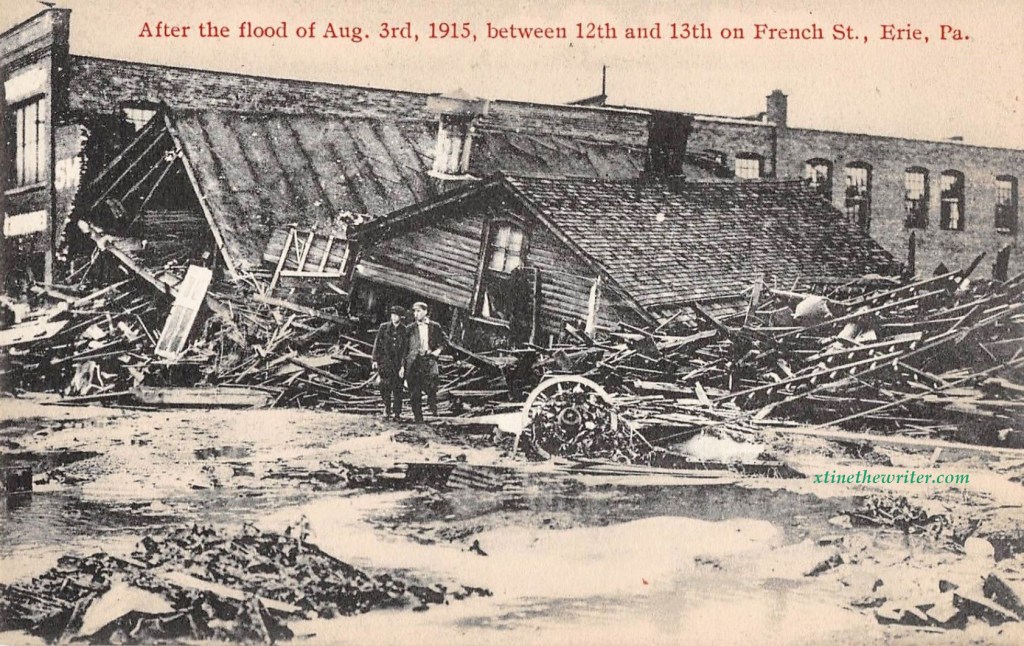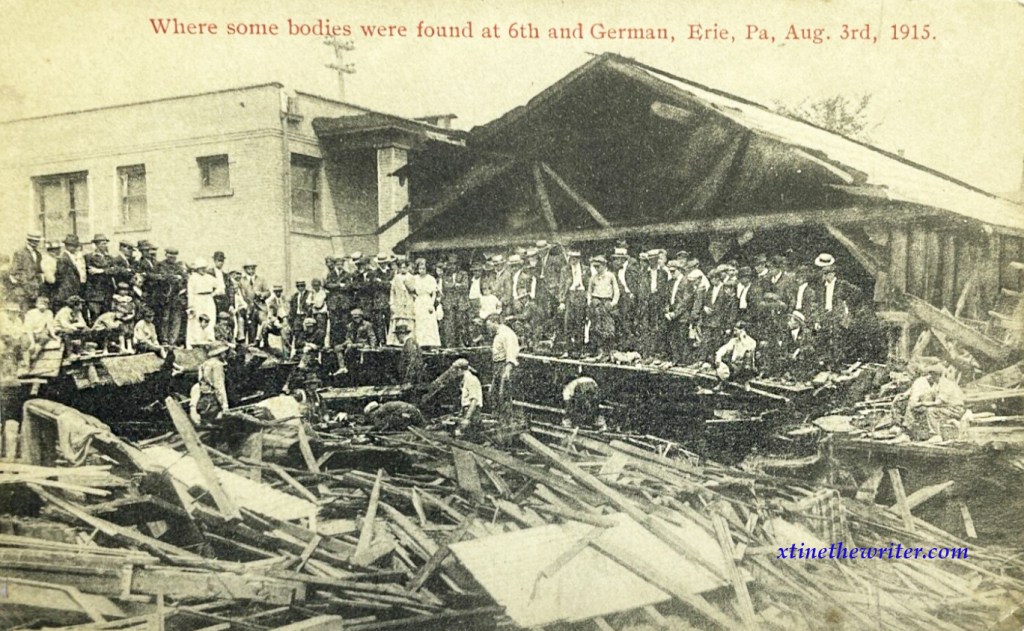by Christine Lorraine Morgan ~ Dec. 13, 2023
NOTE: After being hired as a reporter for The Millcreek Sun newspaper in 1987, I felt compelled to research and present as much information as possible about the history of Millcreek Township as well as the creek after which it was named. This quest led to a two-part feature story, which included multiple one-on-one interviews with local people who had seen and/or survived the 1915 Mill Creek flood.
Not sure where the original articles and details are, but I did recently find my hand-written notes and quotes from this May 1987 interview with Mary Sander, whose family and home survived the flood. This story is the result of that discovery.
Because there were no electronic media in 1915, a multitude of postcards allowed people everywhere to see the devastation caused by this tragic flood. Some of those postcard images are included with this feature to help offer a visualization of what happened.
* * * * *
When Erie resident Mary Sander was a child, her father owned and operated a store on State Street. They lived nearby, on East 11th between Holland and German. At that time, Mill Creek flowed openly through the City of Erie to Presque Isle bay, where the city’s earliest roots began because the creek was powerful enough to sustain milling operations, thus its name.
When unexpected heavy bouts of rainfall caused Mill Creek to rise on Aug. 3, 1915, Mary’s father was at the store. She said he “transferred stuff out of the cellar and put it up high. When he finished, he couldn’t get across French Street because the water was too high, so he crossed the railroad bridge at 14th and French” to reach his home.
Even though the rising water was a concern, Mary’s father had absolutely no idea that a creek-propelled high-velocity flood rush was coming. He was somewhat fascinated by how different these familiar streets looked in the high-water downpour.
Upon arriving home, he urged his family to come outside with him to have a look around. Shaking off the rain he said excitedly, “Oh, you’ve got to see it!”
“No! Don’t go!” Mary’s mother exclaimed. She was against leaving the security of their solid house and roof to see high waters that had accumulated around downtown Erie. She adamantly refused to go with him. Mary was only six years old at the time, and her mother feared for her young children’s safety.
Disregarding his wife’s wishes, Mary’s dad took his two children to the front porch of a house near 12th and French so they could see the effects of the evening’s rapid rainfall. One sight Mary recalled was a waterfall of 6 to 8 feet “under the 11th Street bridge between French and Holland.”
Prior to the flooding of the city, there were multiple storms between 3:30 and 7:30 p.m., and each brought on a measurable volume of rainfall. Official records indicate that 5.77″ of rain came down between 3:30 p.m. and 5 a.m. the following day.
As they witnessed the raging storm, their father noticed “the water getting higher. Dad said, ‘I think we better go home.’
“Shortly thereafter, the house on E. 12th and French where we stood on the porch was washed away and destroyed.”

This postcard from 1915 shows the area where Mary and her father and sibling stood on a porch to watch the waterfall at the 11th Street bridge.
At 26th Street, Mill Creek traveled through a culvert that was 20′ wide and 14′ at the arch’s crown. There was an earthen fill about 33′ higher than the normal level of water and 200 feet in length that prevented the creek from flooding.

Seeing what happened to the culvert at 26th near State helps one understand why Mill Creek was encased in concrete tubing by 1920 from 30th Street to where it empties into Presque Isle Bay.
“At 8:30 p.m. the water, which had overtopped the fill on both sides of the culvert, washed it out and the accumulated water rushed down through the thickly built up valley below at a velocity approaching at some places, 15 miles per hour,” according the Erie, PA Times-News on Sunday, Aug. 3, 1975 in a piece by Vicki Sanfilippo.
But the wildly rushing volume of water into the unprepared city was only one element of the flood’s destructiveness. The creek’s high velocity brought with it tons of debris that continued to accumulate as it traveled north, wiping out nearly everything in its path. House portions, barns, trees, wagons, furniture, bricks, brush and even toys were carried through the channel, clogging the various culvert and bridge openings above the creek throughout the city.
“Many of the culverts at street crossings below were inadequate to pass floods of high intensity and besides were clogged or partly clogged. When the great volume from 26th descended upon them, they were overwhelmed, and each street embankment in succession was overtopped and destroyed,” the Times-News article continued.

The very top of a street crossing culvert is visible in this image from the 1915 flood. Children and adults in this picture are milling around, observing, probably still in shock. Some of them escaped the flood with only the clothes on their backs.
The oversized banner headline of the Aug. 4, 1915 Erie Daily Times Flood Extra stated, “21 bodies recovered; believed 30 still missing in disaster.” Other headlines said, “Fifty low estimate, says coroner; two more bodies are identified at morgue…City suffers greatest loss in its history…Fund for flood sufferers open.”
After showing Mary Sander pictures of the flood, it was obvious that a chord had been struck in her memory. She grew quiet for a moment, then looked over at a framed picture of her father that sat on a shelf nearby. Then she expressed how relieved her parents were that their family had managed to survive such a horrific ordeal.
“Some houses were turned 180 degrees and removed from their foundations. The houses on East 10th Street between French and German took it bad because of that waterfall,” she added, referring to the waterfall they had observed under the 11th Street bridge.

This postcard view shows the devastation of 10th Street that Mary described as being “bad because of that waterfall” at the 11th Street bridge that she witnessed.
* * * * *
Here are some additional postcard images from the flood of Mill Creek

Commerce building which stood at the NE corner of 12th and State until the late 1980s is dominant in this picture. It obviously withstood the flood.



Listen to this article here:

